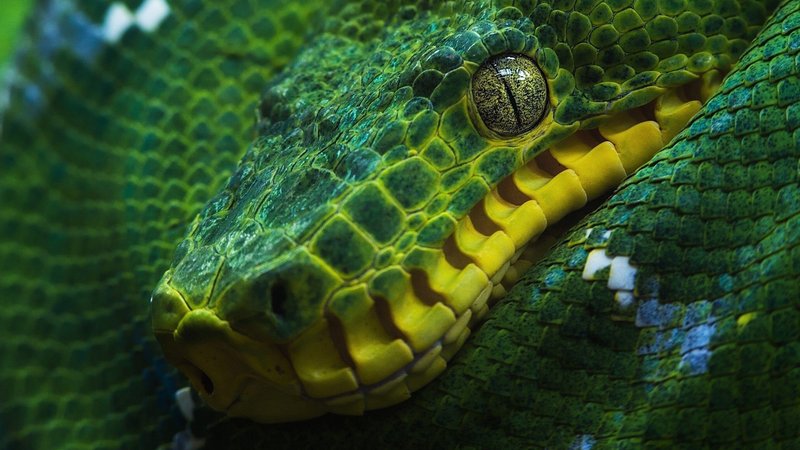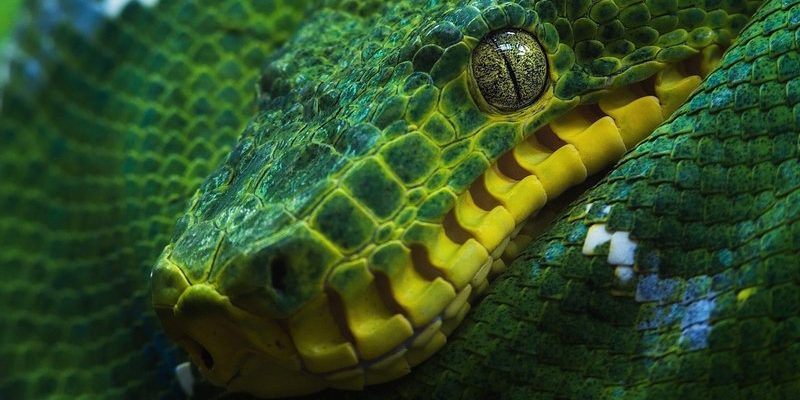
When you think of snakes, perhaps the first image that comes to mind is that of a massive boa constrictor coiled comfortably on a branch, basking in the warm sun. These magnificent serpents are not only fascinating because of their size but also due to their unique behavior and ecological importance. The boa constrictor, known scientifically as Boa constrictor, belongs to the family Boidae and is native to Central and South America, where it plays a vital role in the ecosystem.
Imagine strolling through a lush rainforest, surrounded by the sounds of chirping birds and rustling leaves. Suddenly, you glimpse a boa constrictor slithering silently among the branches overhead. These non-venomous snakes are renowned for their ability to blend seamlessly into their surroundings, making them expert ambush predators. In this article, we’ll explore everything you need to know about these impressive reptiles, from their habitats to their behavior and diet.
Physical Characteristics
Boa constrictors are among the largest snakes in the world, and their size can be quite impressive. Adult boas can grow anywhere from 6 to 12 feet long, with some exceptional individuals reaching lengths of up to 18 feet! They are known for their thick bodies, which can measure up to a foot in diameter, especially in mature males and females.
Their skin is a mix of earthy colors—generally, shades of brown, tan, and grey—making them excellent at camouflaging in their natural habitats. The pattern usually includes dark spots and splotches, which help them remain hidden from both predators and prey. The boa constrictor’s head is distinctly triangular, making it easy to identify at a glance.
A unique feature of boa constrictors is their heat-sensing pits, located on their upper jaw. These pits allow them to detect the body heat of warm-blooded animals, which is incredibly useful for hunting. When hunting at night, these snakes can efficiently locate their prey using this remarkable adaptation.
Habitat and Distribution
Boa constrictors thrive in a variety of habitats, which adds to their adaptability as a species. They are commonly found in tropical rainforests but also inhabit scrublands, savannas, and semi-arid regions. You might be surprised to learn that they can even be found in some urban areas where there are green spaces.
This species primarily resides in Central and South America, from the southern United States down to Argentina. They’re often seen in trees, but they can also be found on the ground. Their ability to climb allows them to escape danger and seek out warm spots basking on branches.
Interestingly, boa constrictors have a knack for living close to water. They’re excellent swimmers and often hunt for prey in or near rivers, lakes, and swamps. It’s not uncommon to see them swimming gracefully in the water while searching for prey like birds, rodents, and other small mammals.
Diet and Hunting Techniques
As constrictors, these snakes rely on their strength to subdue prey rather than venom. Boa constrictors primarily feed on small to medium-sized mammals and birds. Their diet can include animals like rats, rabbits, and even monkeys in some regions. You might find it fascinating that they can consume animals larger than their own diameter by constricting and suffocating them before swallowing them whole.
The boa constrictor employs a unique hunting strategy. They often lie in wait, blending into their surroundings, and use their heat-sensing pits to detect potential meals. When they spot a target, they strike quickly and wrap around it, applying immense pressure until the prey can no longer breathe. This technique is incredibly effective, making them efficient predators in the wild.
After successfully hunting, boas have a remarkable ability to unhinge their jaws to swallow prey whole. The process can take several hours or even days, depending on the size of the meal. Afterward, the boa may go several weeks without needing to eat again, utilizing stored energy from the meal to sustain itself.
Behavior and Temperament
When it comes to behavior, boa constrictors are generally solitary creatures. They are most active during the night (nocturnal), which is when they’re out hunting. In contrast to popular belief, these snakes aren’t aggressive unless provoked. Instead, they tend to be quite docile, making them a favorite among reptile enthusiasts and pet owners alike.
Boa constrictors have an interesting way of communicating. They primarily rely on scent and touch to interact with one another. During mating season, males will engage in combat with one another, using their strength to win the favor of a female. This often involves curling around each other and trying to push the opponent off balance.
Interestingly, when threatened, a boa constrictor might hiss loudly, puff up its body, or even make a break for it to escape danger. They don’t typically strike unless absolutely necessary, preferring to avoid confrontation whenever possible. Their calm demeanor paired with their striking appearance makes them a captivating subject of study and admiration.
Reproduction and Lifespan
Boa constrictors are ovoviviparous, meaning they give birth to live young rather than laying eggs. The mating season usually occurs during the warmer months, around March to August, when both males and females are actively looking for partners. After mating, the female can retain the male’s sperm for several months, giving her flexibility in terms of timing for giving birth.
Typically, a female boa constrictor will give birth to between 20 and 60 babies in a single litter. The newborns are around 2 to 3 feet long and are fully independent from the moment they are born. It’s essential to note that the mother does not care for her young after birth, as they are ready to hunt and fend for themselves.
| Characteristic | Details |
| Length | 6 to 12 feet, can reach up to 18 feet |
| Weight | 40 to 100 pounds |
| Habitat | Tropical rainforests, scrublands, savannas |
| Diet | Small to medium-sized mammals and birds |
| Lifespan | 20 to 30 years in the wild, up to 40+ years in captivity |
| Reproduction | Ovoviviparous; 20 to 60 live young |
Conservation Status
While boa constrictors are not currently classified as endangered, various threats impact their populations. Habitat loss, illegal capture for the pet trade, and hunting pose significant risks to their survival. As human activity continues to encroach on their natural habitats, it’s essential to raise awareness about their ecological significance and the need for conservation efforts.
Organizations are working tirelessly to protect boa constrictors and their habitats. Educational programs aim to teach communities about the importance of these snakes and how they contribute to the ecosystem by controlling rodent populations. By fostering a sense of respect and appreciation for wildlife, we can help safeguard the future of the boa constrictor and other fascinating species.
Conservation efforts also involve habitat restoration, ensuring that these snakes have safe spaces to thrive and reproduce. By supporting responsible pet ownership and discouraging the illegal wildlife trade, we can all play a role in protecting the boa constrictor for generations to come.
FAQ
How can I tell if a boa constrictor is healthy?
A healthy boa constrictor will have clear, bright eyes, smooth and intact skin without signs of parasites or wounds, and a regular feeding schedule. You should also see it actively exploring its environment. Changes in behavior, such as lethargy or lack of appetite, may indicate health issues that require veterinary attention.
Can boa constrictors be kept as pets?
Yes, boa constrictors can be kept as pets, but they require significant care and responsibility. Owning a boa constrictor typically involves providing a proper habitat, ensuring a balanced diet, and having knowledge about their behavior and health needs. If you’re considering one as a pet, it’s essential to do thorough research first.
What do I do if I encounter a boa constrictor in the wild?
If you encounter a boa constrictor in the wild, it’s best to keep a safe distance and observe from afar. These snakes are generally not aggressive and will avoid confrontation. If they feel threatened, they may hiss or try to escape. It’s crucial not to approach or attempt to capture the snake, as this could provoke a defensive reaction.
Are boa constrictors dangerous to humans?
Boa constrictors are non-venomous and relatively docile snakes. While they can bite if they feel threatened, they are not considered dangerous to humans. Their primary method of subduing prey is constriction, not aggression toward people. However, caution should always be exercised when interacting with any wild animal.
How long can a boa constrictor go without food?
Boa constrictors can go several weeks without food, depending on factors such as age, size, and recent meals. After consuming a large meal, they may not need to eat again for a month or more, as they have efficient digestive systems that allow them to utilize stored energy effectively.
Do boa constrictors have any natural predators?
While adult boa constrictors have very few natural predators due to their size, they can be vulnerable to larger birds of prey, jaguars, and humans. Young boas are more susceptible to predation by various animals, including birds and larger snakes. Maintaining a healthy population is essential for their survival.
Can boa constrictors swim?
Yes, boa constrictors are excellent swimmers! They can move gracefully through water and often hunt for prey in rivers and ponds. Their ability to swim also helps them escape from potential threats and navigate their environments effectively.
What is the best habitat setup for a pet boa constrictor?
A proper habitat for a boa constrictor should include a large enclosure with good ventilation, adequate hiding spots, and climbing opportunities. The temperature should be maintained between 80°F and 90°F on one side of the enclosure and cooler on the other. Humidity levels should be kept between 50-70% to support their health and hydration needs.
Are there different types of boa constrictors?
Yes, there are several subspecies of boa constrictors, including the common boa, the yellow anaconda, and the red-tail boa. Each subspecies has distinct coloration and patterns, adapting to its specific environment. These variations make them even more fascinating to study and observe in the wild.

